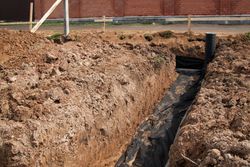How Incorrect Sewer Repair Can Cause Sinkholes

While sewer repairs are often urgent, it is not an excuse to settle for subpar work. Low-quality repairs by amateurs can make the situation worse by causing sinkholes to form over the site. Below is a brief explanation of how sinkholes form and how plumbing work is involved.
What Is a Sinkhole?
A sinkhole is an area where the surface of the ground collapses, often taking paving or landscaping with it. They can be almost any size, from a few feet across to several hundred yards in diameter. They are caused when soil or stone erodes invisibly from under the area, weakening the support for the surface of the soil until it collapses. This can occur naturally, but it is often due to human activity.
How Sewer Repairs Are Involved
 Building a sewer requires creating large, hollow areas underground for pipes. To access them, plumbers and occasionally less qualified individuals dig down to the pipe, then fill in the hole afterward. This presents a few opportunities for sinkholes to form. A large pipe could collapse, abruptly removing support from the dirt above it, or a burst pipe could create an area of flowing water underground, which washes away the soil and creates perfect conditions for a sinkhole to form. Additionally, some contractors may not fill the hole with enough material or compact it thoroughly, which encourages erosion. Fortunately, a high-quality plumber will use the appropriate pipe materials for your area and finish the job with fresh, compacted soil to avoid creating an issue on your property.
Building a sewer requires creating large, hollow areas underground for pipes. To access them, plumbers and occasionally less qualified individuals dig down to the pipe, then fill in the hole afterward. This presents a few opportunities for sinkholes to form. A large pipe could collapse, abruptly removing support from the dirt above it, or a burst pipe could create an area of flowing water underground, which washes away the soil and creates perfect conditions for a sinkhole to form. Additionally, some contractors may not fill the hole with enough material or compact it thoroughly, which encourages erosion. Fortunately, a high-quality plumber will use the appropriate pipe materials for your area and finish the job with fresh, compacted soil to avoid creating an issue on your property.
To avoid sinkholes and to ensure excellent quality control, choose Chugach Sewer and Drain in Anchorage, AK, to handle your sewer repairs. In addition to a full range of plumbing repairs and maintenance, they offer hydrojet cleaning to clear roots and buildup from your pipes. Visit them online to learn more about their services, and call (907) 929-5072 to schedule their services.
About the Business
(7 reviews)
Have a question? Ask the experts!
Send your question

